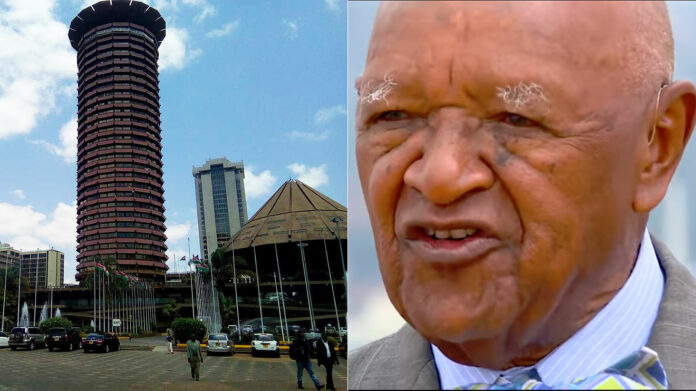Kenya’s first African Chief Architect David Mutiso is the brain behind the Iconic Kenyatta International Conference Centre (KICC).
Born on 10th July 1932, Mutiso went to several primary schools in Manyatta and Mwala before joining Alliance High School between 1949 and 1952.
In a past interview, Mutiso said his interest in architecture developed by chance during one of his school holidays when he visited an uncle who worked as a cook for a white man.
His uncle was lighting up a fire using what he later learned was, building plan blueprints. On close scrutiny, he noticed that these were signed by Architect Imray Rosa.
His uncle would later explain that his boss is an architect and told Mutiso what he actually did. Mutiso developed a keen interest in the profession and discussed it with his principal at Alliance, Carey Francis.
Carey tried to help him by introducing him to some white architects. This, however, did little to help as the same architects discouraged him by lamenting that he would have no clients to design for since all Africans lived in mud huts.
High schools that produced some of Kenya’s top tycoons
After his O Levels and with the hurdles along his route into architecture, Mutiso did not pursue his dream of becoming an architect.
He joined Makerere University in 1953 for a Bachelor of Science degree in Mathematics, Biology, Chemistry, and Physics.
His return coincided with openings at the City Council of Nairobi for positions of draftsmen. Mutiso thought he should give his dream another attempt. He applied and joined as a learned draftsman.
To hone his skills, he enrolled for evening classes at a technical college within town. It was while he was working at the City Council of Nairobi that the colonial government advertised bursaries for students interested in studying abroad.
This opportunity was only available to Makerere Alumni to which Mutiso belonged. On application, he was invited for an interview. Things looked positive for him since his former principal at Alliance was on the interviewing panel.
He was awarded a full scholarship which enabled him to Join the University of Sheffield in 1954. He graduated in 1959 and worked for some time before joining RIBA in 1960.
He served apprenticeships with J. Womersley, City Architect of the Sheffield Corporation (1959-1960), ProfessorQuaroni in Italy, and Richard Hughes in Kenya (1961-1962).
Kenyan tycoons whose multi-billion businesses collapsed and why they failed
When Kenya was about to get independence, Mutiso was offered to join the government as a planner. He heeded the call and joined the Planning Department in 1964 after completing his post-graduate studies in the UK.
He rose through the ranks, becoming the Superintendent Architect, second in command after the chief architect in the Ministry of Public Works in 1965. When the Chief Architect retired in 1967, Mutiso took over.
It was in 1968 when he was contacted by then-Kanu Secretary General Tom Mboya to design the headquarter of the then-ruling party.
“It was some time in 1968 when Tom Mboya, KANU Secretary General, called my office and asked for a meeting. During our meeting, he revealed that the party wanted a building that would be its headquarters that would have facilities for the governing council to meet.” He said.
Mutiso further revealed that he worked closely with Norwegian architect Karl Henrik Nøstvik who was his junior in government and assisted him in the project.
While the project was ongoing, Karl’s contract with the government lapsed and he was appointed as a private consultant for the project.
Meet the little-known tycoon behind the popular Afia juice
Mutiso said he had developed the sketches, and before he shared them with Tom Mboya, he happened to meet Kenya’s first president, Jomo Kenyatta, at State House on other matters where he mentioned the project to him.
Kenyatta developed an interest in the project and instructed that they have weekly briefings on the project. The construction was done in three phases.
First, they started with the podium, then the tower, and later the plenary at a total cost of Sh80 million.
He recalled several incidents which earned a great number of enemies within government circles. In late 1973 that he quit his government role after being accused of corruption.
Mutiso was on an official trip to Canada and South America to learn from their experiences in social housing, accompanied by his wife.
On his return, government agents from the police and CID accused him of corruption for taking his wife along on official government trips.
He was upset by these moves and chose to quit the position after ten years of service to the government. He joined Braz Menezes and later formed MutisoMenezes International, a firm of Architects, Project Managers, and Interior Design Consultants.

